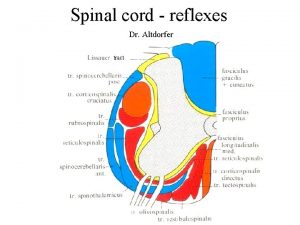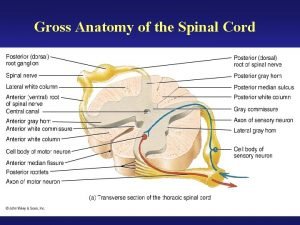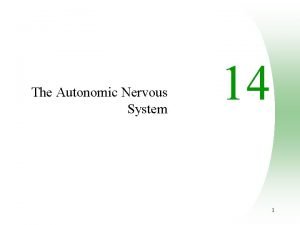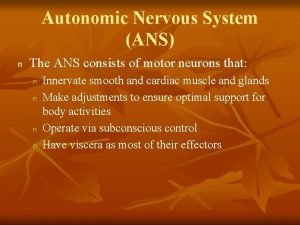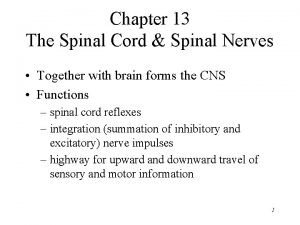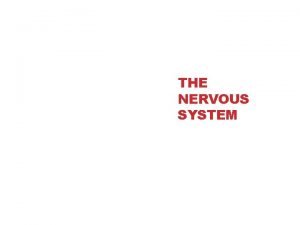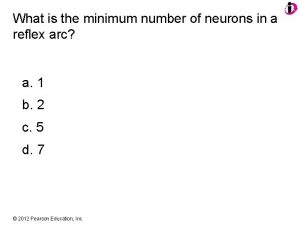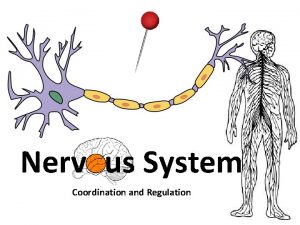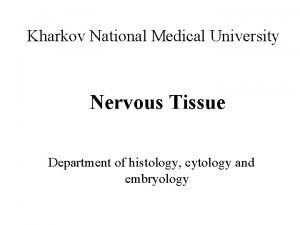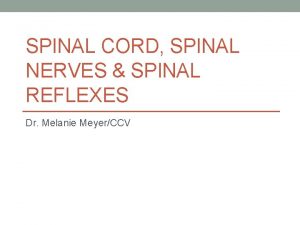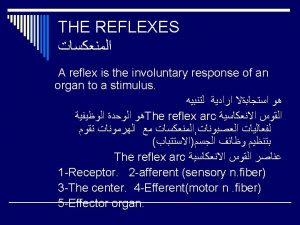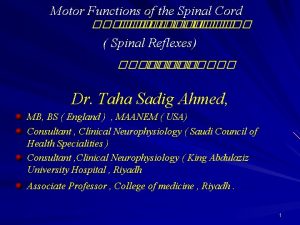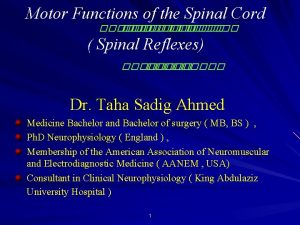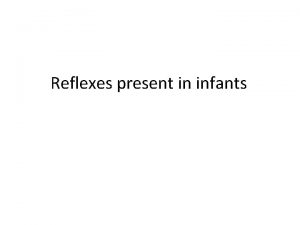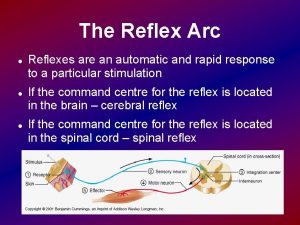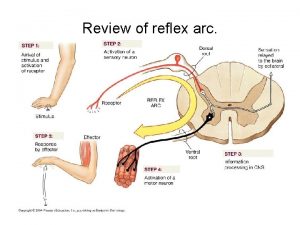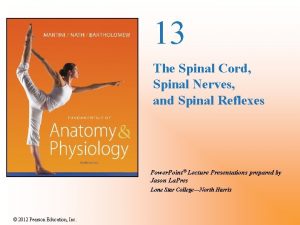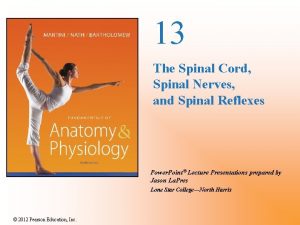Spinal reflexes The reflex arc The reflex arc
























- Slides: 24

Spinal reflexes The reflex arc

The reflex arc l l An automatic, rapid response to an adverse stimulus. Action is involuntary the brain is not involved in the event but may be informed of it Many reflex actions are protective Some complex actions (swallowing, coughing and blinking) are coordinated by reflexes.

A simplified reflex arc stimulus

A simplified reflex arc stimulus receptor

A simplified reflex arc stimulus sensory neurone receptor

A simplified reflex arc stimulus sensory neurone receptor spinal cord of central nervous system

A simplified reflex arc stimulus sensory neurone receptor relay neurone spinal cord of central nervous system

A simplified reflex arc stimulus sensory neurone receptor relay neurone motor neurone spinal cord of central nervous system

A simplified reflex arc stimulus sensory neurone receptor relay neurone effector motor neurone spinal cord of central nervous system

A simplified reflex arc stimulus sensory neurone receptor relay neurone response effector motor neurone spinal cord of central nervous system

A withdrawal reflex

A withdrawal reflex The stimulus is the heat from the hot object

A withdrawal reflex The stimulus is detected by receptors in the dermis of the skin. Since these sensory cells respond to temperature, they are called thermoreceptors. The stimulus is the heat from the hot object

A withdrawal reflex The stimulus is detected by receptors in the dermis of the skin. Since these sensory cells respond to temperature they are called . thermoreceptors The stimulus is the heat from the hot object The thermoreceptors initiate nerve impulses that pass to the spinal cord along a sensory neurone.

A withdrawal reflex The stimulus is detected by receptors in the dermis of the skin. Since these sensory cells respond to temperature they are called . thermoreceptors The thermoreceptors initiate nerve impulses that pass to the spinal cord along . a sensory neurone cell body The stimulus is the heat from the hot object

A withdrawal reflex The stimulus is detected by receptors in the dermis of the skin. Since these sensory cells respond to temperature they are called . thermoreceptors The thermoreceptors initiate nerve impulses that pass to the spinal cord along . a sensory neurone cell body The stimulus is the heat from the hot object grey matter (neurone cell bodies)

A withdrawal reflex The stimulus is detected by receptors in the dermis of the skin. Since these sensory cells respond to temperature they are called . thermoreceptors The thermoreceptors initiate nerve impulses that pass to the spinal cord along . a sensory neurone cell body grey matter (neurone cell bodies) The stimulus is the heat from the hot object spinal cord

A withdrawal reflex The stimulus is detected by receptors in the dermis of the skin. Since these sensory cells respond to temperature they are called . thermoreceptors The thermoreceptors initiate nerve impulses that pass to the spinal cord along . a sensory neurone cell body grey matter (neurone cell bodies) The stimulus is the heat from the hot object spinal cord white matter (neurone axons)

A withdrawal reflex The stimulus is detected by receptors in the dermis of the skin. Since these sensory cells respond to temperature they are called . thermoreceptors The thermoreceptors initiate nerve impulses that pass to the spinal cord along . a sensory neurone cell body grey matter (neurone cell bodies) The stimulus is the heat from the hot object spinal cord white matter (neurone axons) The sensory neurone enters the spinal cord via the dorsal branch of the spinal nerve and forms a synapse with a relay neurone, inside the grey matter

A withdrawal reflex The stimulus is detected by receptors in the dermis of the skin. Since these sensory cells respond to temperature they are called . thermoreceptors The thermoreceptors initiate nerve impulses that pass to the spinal cord along . a sensory neurone cell body The stimulus is the heat from the hot object The short relay neurone forms a synapse with a motor neurone that leaves the spinal cord via the ventral root of the spinal cord. grey matter (neurone cell bodies) spinal cord white matter (neurone axons) The sensory neurone enters the spinal cord via the dorsal branch of the spinal nerve and forms a synapse with a relay neurone, inside the grey matter

A withdrawal reflex The stimulus is detected by receptors in the dermis of the skin. Since these sensory cells respond to temperature they are called . thermoreceptors The thermoreceptors initiate nerve impulses that pass to the spinal cord along . a sensory neurone cell body The stimulus is the heat from the hot object The short relay neurone forms a synapse with a motor neurone that leaves the spinal cord via the ventral root of the spinal cord. The motor neurone carries the impulse to an effector, in this case muscles in the arm, which contract to withdraw the hand from the hot object. This action is known as the response. grey matter (neurone cell bodies) spinal cord white matter (neurone axons) The sensory neurone enters the spinal cord via the dorsal branch of the spinal nerve and forms a synapse with a relay neurone, inside the grey matter

A withdrawal reflex The stimulus is detected by receptors in the dermis of the skin. Since these sensory cells respond to temperature they are called . thermoreceptors The thermoreceptors initiate nerve impulses that pass to the spinal cord along . a sensory neurone cell body The stimulus is the heat from the hot object The short relay neurone forms a synapse with a motor neurone that leaves the spinal cord via the ventral root of the spinal cord. The motor neurone carries the impulse to an effector, in this case muscles in the arm, which contract to withdraw the hand from the hot object. This action is known as the response. grey matter (neurone cell bodies) spinal cord white matter (neurone axons) The sensory neurone enters the spinal cord via the dorsal branch of the spinal nerve and forms a synapse with a relay neurone, inside the grey matter

A few reminders! l l l The central grey matter contains the cell bodies of relay and motor neurones. The outer white matter contains myelinated axons, which run up and down the spinal cord to and from the brain. In the centre of the grey matter is the spinal canal, through which the nutritive cerebrospinal fluid circulates.

A few reminders! l l Sensory neurones enter the spinal cord through the dorsal root and the concentration of their cell bodies forms a swelling called the dorsal root ganglion. Motor neurones leave the spinal cord via the ventral root.
 Spinal cord structure
Spinal cord structure Cranial nerves mnemonic
Cranial nerves mnemonic Spine meninges
Spine meninges Innervations of the brachial and lumbar enlargements
Innervations of the brachial and lumbar enlargements Spinal reflex
Spinal reflex An ipsilateral intersegmental spinal somatic reflex
An ipsilateral intersegmental spinal somatic reflex Prevertebral ganglia
Prevertebral ganglia Ans
Ans Landau reflex vs parachute reflex
Landau reflex vs parachute reflex 234
234 Ans
Ans Spinal cord cover
Spinal cord cover Pain in brain stem
Pain in brain stem Autonomic reflexes
Autonomic reflexes 自律神經 wiki
自律神經 wiki Pearson
Pearson Slidetodoc. com
Slidetodoc. com Reflex arc diagram labeled
Reflex arc diagram labeled Spinal cord diagram
Spinal cord diagram What is the correct sequence in a typical reflex arc
What is the correct sequence in a typical reflex arc Renshaw cell inhibition
Renshaw cell inhibition What is the minimum number of neurons in a reflex arc
What is the minimum number of neurons in a reflex arc Cns
Cns Structure of the reflex arc
Structure of the reflex arc Neuromuscular spindle
Neuromuscular spindle




